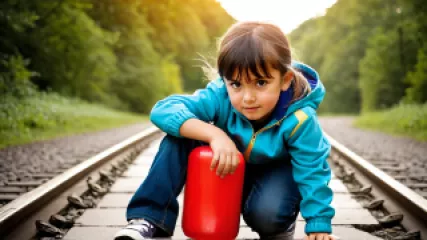The Ultimate Guide to Developing Resilience in Childhood
The Ultimate Guide to Developing Resilience in Childhood
Resilience is a crucial skill that every child should develop to navigate the ups and downs of life successfully. Building resilience in childhood lays the foundation for individuals to bounce back from adversity, handle stress, and thrive in the face of challenges. In this comprehensive guide, we will explore the importance of resilience, the science behind it, and practical strategies to help children build this essential life skill.
Understanding Resilience
Resilience is the ability to adapt and bounce back in the face of adversity, trauma, tragedy, threats, or significant sources of stress. It is not a trait that some people are born with and others are not; rather, it is a skill that can be learned and developed over time. Resilient children are better equipped to handle life's challenges, maintain a positive outlook, and emerge stronger from difficult experiences.
The Science of Resilience
Resilience is a complex process that involves a combination of biological, psychological, and environmental factors. Research has shown that resilience is not a fixed trait, but a dynamic process that can be influenced by various factors, including:
- Genetics and biology: Some individuals may have a genetic predisposition to resilience, which can be influenced by factors such as brain chemistry and stress response systems.
- Childhood experiences: Early childhood experiences, both positive and negative, can shape a child's ability to cope with stress and adversity.
- Relationships and social support: Strong, supportive relationships with family, friends, and other caring adults can foster resilience in children.
- Cognitive and emotional skills: Developing skills such as problem-solving, emotional regulation, and optimism can contribute to resilience.
- Environmental factors: The physical and social environments in which a child grows up can either support or hinder the development of resilience.
Understanding the science behind resilience can help parents, educators, and caregivers develop more effective strategies for building this essential life skill in children.
Developing Resilience in Childhood
Building resilience in children requires a multifaceted approach that addresses various aspects of their development. Here are some key strategies to consider:
Fostering Positive Relationships
Positive relationships with caring adults are a critical component of resilience. Children who have strong, supportive relationships with parents, teachers, mentors, or other trusted adults are more likely to develop the skills and mindset needed to bounce back from adversity. Encourage children to build meaningful connections with caring adults who can provide emotional support, guidance, and a safe haven during difficult times.
Promoting Emotional Regulation
Emotional regulation, the ability to manage and express emotions in a healthy way, is a key component of resilience. Teach children strategies for identifying and expressing their emotions, such as deep breathing, mindfulness, and positive self-talk. Help them develop coping mechanisms to deal with stress and negative emotions, rather than suppressing or avoiding them.
Fostering a Growth Mindset
A growth mindset, the belief that one's abilities can be developed through effort and perseverance, is strongly linked to resilience. Encourage children to view challenges as opportunities for learning and growth, rather than as threats. Praise their efforts and progress, not just their achievements, to reinforce the idea that hard work and determination can lead to success.
Encouraging Problem-Solving Skills
Resilient children are often skilled at problem-solving, as they are able to identify and implement effective strategies to overcome obstacles. Teach children how to break down problems into manageable steps, consider multiple solutions, and persevere until they find a way to overcome the challenge. Provide opportunities for them to practice problem-solving in a supportive environment.
Building Self-Efficacy
Self-efficacy, or the belief in one's own ability to succeed, is a critical component of resilience. Help children develop a sense of mastery and control over their lives by setting achievable goals, providing opportunities for success, and offering constructive feedback. Celebrate their accomplishments, no matter how small, to reinforce their belief in their own capabilities.
Fostering Adaptability
Resilient children are often able to adapt to changing circumstances and find creative solutions to new challenges. Encourage children to be open to new experiences, embrace flexibility, and view change as an opportunity for growth. Teach them strategies for navigating uncertainty, such as problem-solving, flexibility, and a willingness to try new approaches.
Promoting Healthy Coping Strategies
Resilient children often have a repertoire of healthy coping strategies they can draw upon in times of stress or adversity. Teach children a variety of coping mechanisms, such as exercise, meditation, journaling, or engaging in hobbies and creative pursuits. Help them identify which strategies work best for them and encourage them to use these tools when faced with challenges.
Resilience in Action: Real-Life Examples
To illustrate the power of resilience, let's consider the stories of two children who have overcome significant challenges:
Rodger Young: Overcoming a Serious Illness
At the age of 8, Rodger Young was diagnosed with a rare form of cancer. Despite the physical and emotional toll of his treatment, Rodger remained determined to beat the disease. With the support of his family, friends, and healthcare team, Rodger underwent intensive chemotherapy and radiation therapy. Throughout his journey, he maintained a positive attitude, engaged in stress-reducing activities like art and music, and never lost sight of his goal of becoming cancer-free.
"The hardest part was not knowing what the future held, but I knew I had to keep fighting. My family, my doctors, and my friends were there for me every step of the way, and that's what gave me the strength to keep going."
- Rodger Young
After two years of treatment, Rodger was declared cancer-free. Today, he is a thriving young adult, using his experience to inspire and support other children facing serious illnesses.
Harmony Martin: Overcoming Bullying and Adversity
Harmony Martin's childhood was marked by persistent bullying and social exclusion. Despite the emotional pain and isolation she experienced, Harmony refused to let the bullies win. She sought support from her parents, teachers, and a school counselor, who helped her develop coping strategies and a strong sense of self-worth. Harmony also found solace in extracurricular activities, where she could express herself creatively and build positive relationships with her peers.
"The bullying was really tough, but I knew I had to find a way to rise above it. With the help of my family, my teachers, and my own determination, I was able to turn things around and become a stronger, more resilient person."
- Harmony Martin
Today, Harmony is a thriving college student, using her experiences to advocate for anti-bullying initiatives and mentor younger students who are facing similar challenges.
Nurturing Resilience: The Role of Parents, Educators, and Caregivers
Developing resilience in children is a collaborative effort that requires the support and involvement of parents, educators, and other caring adults in a child's life. Here are some key ways these important figures can contribute to building resilience:
Parents
Parents play a crucial role in nurturing resilience in their children. By providing a stable, supportive, and nurturing home environment, parents can help children develop the necessary skills and mindset to cope with adversity. This includes modeling resilient behaviors, fostering open communication, and encouraging children to take healthy risks and learn from their mistakes.
Educators
Teachers and school staff can also significantly impact the development of resilience in children. By creating a safe, inclusive, and supportive classroom environment, educators can help students build important social-emotional skills, such as problem-solving, emotional regulation, and self-efficacy. Additionally, educators can incorporate resilience-building activities and lessons into their curriculum, further reinforcing these essential life skills.
Caregivers and Community
Beyond the immediate family and school environment, children can also benefit from the support of other caring adults in their lives, such as extended family members, mentors, coaches, and community leaders. These individuals can provide additional sources of emotional support, role modeling, and opportunities for growth, further contributing to the development of resilience.
Conclusion: Embracing Resilience for a Brighter Future
Resilience is a critical life skill that can empower children to navigate the challenges of childhood and lay the foundation for a successful, fulfilling adulthood. By understanding the science behind resilience and implementing practical strategies to foster its development, parents, educators, and caregivers can help children build the inner strength and adaptability they need to thrive.
Remember, resilience is not a fixed trait, but a dynamic process that can be nurtured and cultivated over time. By creating supportive environments, teaching essential skills, and modeling resilient behaviors, we can equip the next generation with the tools they need to face adversity head-on and emerge stronger than ever before.
In this comprehensive guide, we have explored the importance of resilience, the science behind it, and practical strategies for developing this essential life skill in children. By fostering positive relationships, promoting emotional regulation, and encouraging a growth mindset, we can help children build the resilience they need to navigate the ups and downs of life.
Remember, the journey to developing resilience is not always easy, but the rewards are immeasurable. By investing in the resilience of our children, we are not only empowering them to overcome challenges but also laying the groundwork for a more resilient, compassionate, and thriving society.
So, let us embrace the power of resilience and work together to nurture this vital skill in the next generation. With the right support and guidance, our children can learn to bounce back from adversity, find strength in the face of challenges, and ultimately, unlock their full potential.






